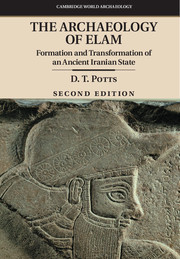Book contents
- Frontmatter
- Dedication
- Contents
- List of illustrations
- List of tables
- Preface to the second edition
- Preface and acknowledgements
- Acknowledgements for photographic reproduction
- List of abbreviations
- Note on transliteration and dating systems
- 1 Elam: what, when, where?
- 2 Environment, climate and resources
- 3 The immediate precursors of Elam
- 4 Elam and Awan
- 5 The dynasty of Shimashki
- 6 The grand regents of Elam and Susa
- 7 The kingdom of Susa and Anshan
- 8 The Neo-Elamite period
- 9 Elam in the Achaemenid empire
- 10 Elymais
- 11 Elam under the Sasanians and beyond
- 12 Conclusion
- References
- Index
7 - The kingdom of Susa and Anshan
Published online by Cambridge University Press: 18 December 2015
- Frontmatter
- Dedication
- Contents
- List of illustrations
- List of tables
- Preface to the second edition
- Preface and acknowledgements
- Acknowledgements for photographic reproduction
- List of abbreviations
- Note on transliteration and dating systems
- 1 Elam: what, when, where?
- 2 Environment, climate and resources
- 3 The immediate precursors of Elam
- 4 Elam and Awan
- 5 The dynasty of Shimashki
- 6 The grand regents of Elam and Susa
- 7 The kingdom of Susa and Anshan
- 8 The Neo-Elamite period
- 9 Elam in the Achaemenid empire
- 10 Elymais
- 11 Elam under the Sasanians and beyond
- 12 Conclusion
- References
- Index
Summary
The period of the sukkalmahs was followed by the Middle Elamite period. While details of the transition between these two eras are lacking, the onset of the Middle Elamite period is usually put at c. 1500 BC, its end at c. 1100 BC. Three phases have been distinguished, each marked by a different dynasty named after its founder or most significant early leader (thus the Kidinuids, Igihalkids and Shutrukids). This is the period when the title ‘king of Susa and Anshan’, as it is expressed in Akkadian texts, or ‘king of Anshan and Susa’, according to the usage of the Elamite sources, is attested.
The first phase of this period (Middle Elamite I, c. 1500–1400 BC) is notable not only for the wealth of evidence from Susa but for the expansion of an important site at Haft Tepe by a king named Tepti-ahar (De Graef 2011g). The second phase (Middle Elamite II, c. 1400–1200 BC) is characterized by intermarriage with the royal family of the contemporary Kassite dynasty in Babylonia. This was also the time when one of the Middle Elamite II period's most important rulers, Untash-Napirisha, founded a monumental new site at Choga Zanbil, ancient Al Untash-Napirisha, complete with a stepped temple tower or ziggurat, where the deities of the highlands were worshipped alongside those of the lowlands. Susa, too, provides abundant evidence of occupation at this time. The third phase (Middle Elamite III, c. 1200–1100 BC) saw the overthrow of the Kassites by one of the most belligerent figures in Elamite history, Shutruk-Nahhunte. It was he, following his conquest of southern Mesopotamia, who brought to Susa such significant monuments as the stele bearing the inscribed law code of Hammurabi, the victory stele of the Old Akkadian king Naram-Sin, and many other pieces of Mesopotamian statuary, booty taken during his victorious campaign in 1158 BC. Shutruk-Nahhunte's son and successor, Kutir-Nahhunte, meted out even more punishment to his western neighbours, removing the all-important cult statue of Marduk from his temple at Babylon. Likewise Kutir-Nahhunte's successor, Shilhak-Inshushinak, campaigned widely, particularly in eastern and northeastern Mesopotamia.
Important archaeological finds from this latest phase of the Middle Elamite era have been recovered at Tal-i Malyan in Fars, and rock reliefs near Izeh add yet another dimension to our understanding of political fragmentation and religious practice in this period.
- Type
- Chapter
- Information
- The Archaeology of ElamFormation and Transformation of an Ancient Iranian State, pp. 176 - 248Publisher: Cambridge University PressPrint publication year: 2015

